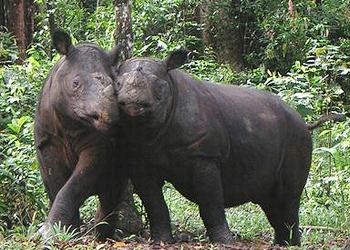 |
| Sumatran rhinos (Photo by Dedi Candra / Yayasan Badak Indonesia) |
The governments of Indonesia and Malaysia today agreed for the first
time to collaborate on saving the Critically Endangered Sumatran rhino,
the smallest and last form of the two-horned rhino in Asia that has
lived on the planet for 20 million years.
The last wild populations of Sumatran rhino, Dicerorhinus sumatrensis,
amount to fewer than 100 rhinos in total. They survive on the
Indonesian island of Sumatra and in Sabah, Malaysia on the northern part
of the island of Borneo.
The agreement was reached at the Sumatran Rhino Crisis Summit
convened by the International Union for Conservation of Nature’s Species
Survival Commission (IUCN SSC) at the Singapore Zoo with a wide range
of international and national organizations.
Experts gathered at the summit proposed a two-year emergency action
plan as an immediate follow-up to the event. The two governments now
need to formalize the collaboration and agree on the next steps to
tackle the Sumatran rhino crisis, brought on by an increase in illegal
hunting and consumer demand for rhino horn.
Datuk Dr. Laurentius Ambu, director of the Sabah Wildlife Department,
detailed some of the initiatives the two countries will take to
conserve the last Sumatran rhinos.
“We would like to reiterate Sabah’s commitment and our willingness to
further discuss with Indonesia opportunities to exchange reproductive
cells of the species, move individual rhinos between our countries and
to employ advanced reproductive technology as a parallel initiative in
the Sumatran rhino captive breeding program,” he said.
Dr. Ambu made this pledge to more than 130 rhino experts, scientists,
government officials and representatives of nongovernmental
organizations from around the world gathered in Singapore this week to
address the Sumatran rhino crisis.
They made their plans in view of lessons learned from previous
conservation successes of other rhinos and species such as the
Californian condor, the black-footed ferret and Hawaiian forest birds.
“Serious steps must be taken to roll back the tide of extinction of
the Sumatran rhino,” said Widodo Ramano, executive director of the
Indonesian Rhino Foundation, Yayasan Badak Indonesia, a nongovernmental
organization.
“This could be our last opportunity to save this species and, by
working together as a collaborative unit, internationally and
regionally, with an agreed vision and goals, a glimmer of hope has been
clearly demonstrated,” he said.
“We need to act together urgently, hand in hand, replicating some of
the inspirational successes of other conservation efforts and aim to
stop any failures that might impede progress,” Ramano said.
“The Sumatran Rhino Crisis Summit has been transformational by
bringing together the two governments whose representatives committed to
positive and proactive bilateral collaboration which is critical for
saving this enigmatic species,” says Mark Stanley Price, chairman of the
IUCN SSC Species Conservation Planning Sub-Committee.
“Huge progress has been made in specifying the resources needed to
improve rhino surveys, security and monitoring,” said Price. “We have
also explored the potential of new technologies and the role of
integrating the management of wild and captive individuals.”
Summit participants were encouraged by the agreement, although the recent past history of rhinos has been bleak.
Read more: Environment News Service







0 comments:
Post a Comment